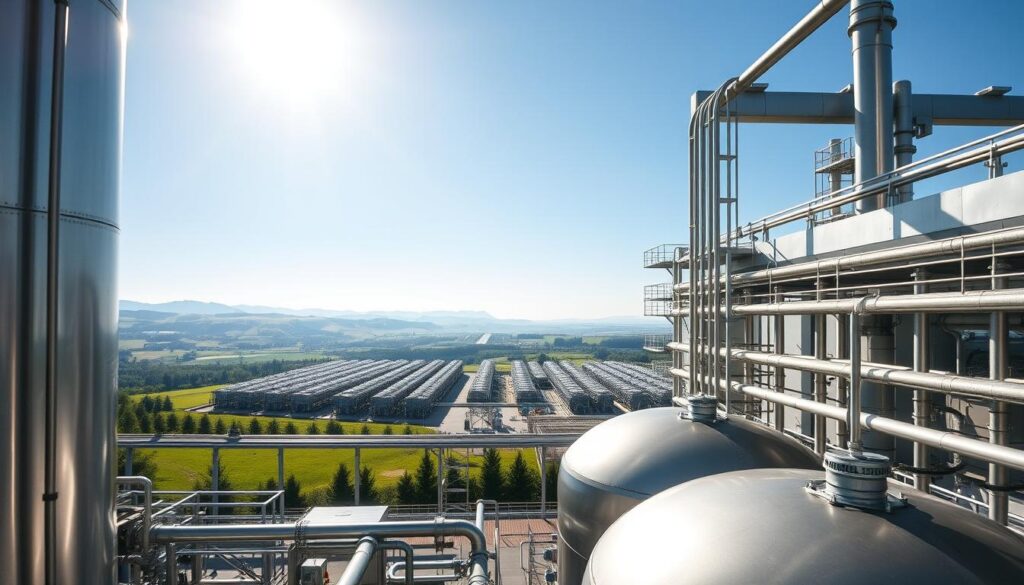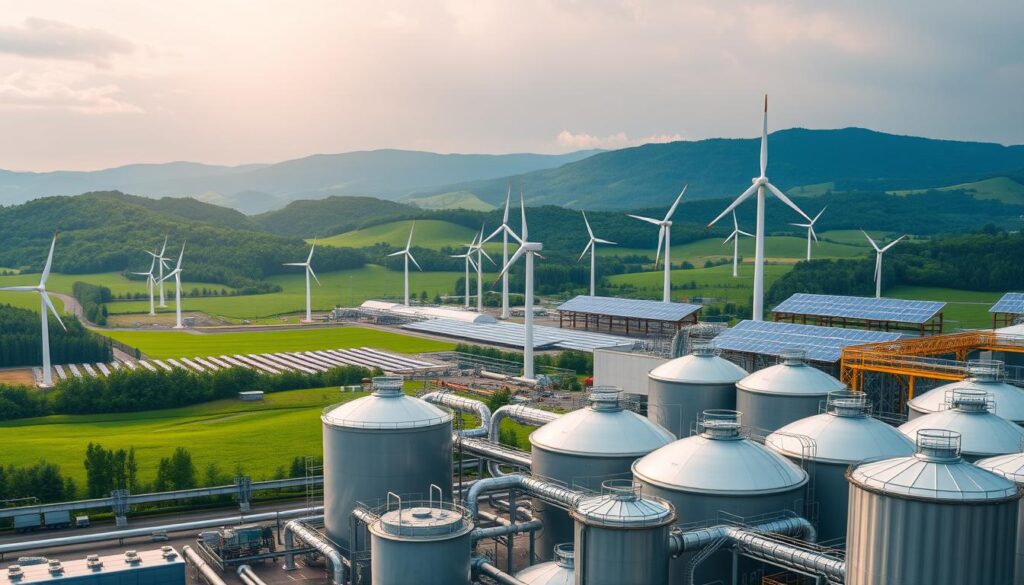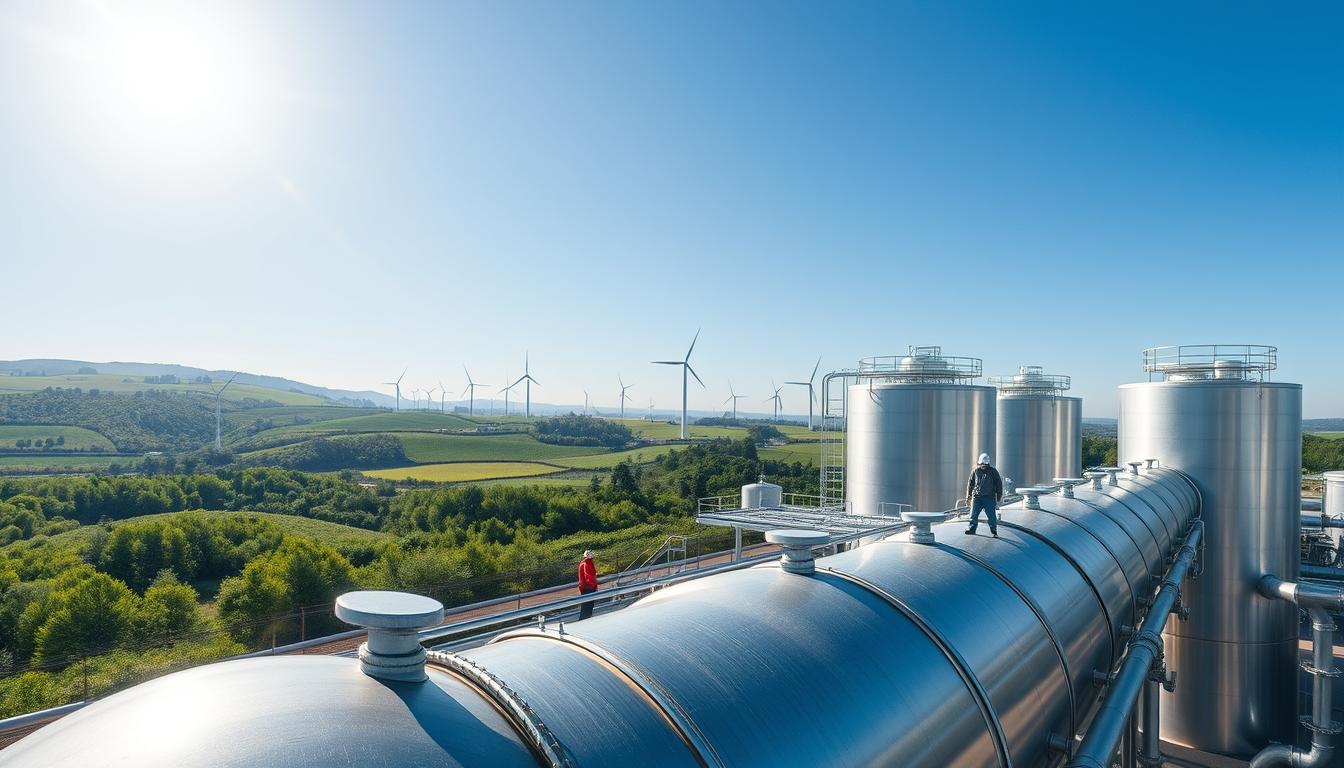Germany is at the forefront of the energy transition, aiming to achieve 80% of its electricity from renewables by 2030. A crucial aspect of this transition is the adoption of sustainable ammonia production methods, which play a significant role in reducing carbon emissions.
The country’s current energy mix is undergoing a significant transformation, with a growing emphasis on renewable energy sources. Eco-friendly ammonia is emerging as a vital component in this shift, contributing to a more sustainable energy landscape.
Key Takeaways
- Germany’s energy transition relies heavily on renewable energy sources.
- Sustainable ammonia production is crucial for reducing carbon emissions.
- Eco-friendly ammonia plays a significant role in achieving climate neutrality.
- Germany aims to achieve 80% of its electricity from renewables by 2030.
- The adoption of green ammonia production methods is on the rise.
Overview of Green Ammonia and Its Importance
As Germany continues its transition towards renewable energy, green ammonia is playing an increasingly vital role. Green ammonia is produced using renewable energy sources, making it a cleaner alternative to traditional ammonia production methods.
Definition of Green Ammonia
Green ammonia refers to ammonia that is produced using renewable energy, typically through the process of electrolysis to generate hydrogen, which is then combined with nitrogen to form ammonia. This method significantly reduces the carbon footprint associated with traditional ammonia production.
The production of green ammonia involves renewable ammonia production techniques, ensuring that the entire process, from hydrogen generation to ammonia synthesis, is powered by renewable energy sources.
Benefits of Green Ammonia
The benefits of green ammonia are multifaceted. Firstly, it offers a significant reduction in greenhouse gas emissions compared to conventional ammonia production methods. Secondly, green ammonia can play a crucial role in the storage and transportation of renewable energy, making it a valuable component in the energy transition.
- Reduced carbon footprint
- Potential for renewable energy storage and transport
- Supports the transition to a more sustainable energy mix
Furthermore, the use of green ammonia in various industries, including agriculture and energy, can contribute to a more sustainable future. The production of green ammonia in facilities across Germany is expected to boost the country’s green ammonia facilities Germany, enhancing its position in the global renewable energy landscape.
Role in Renewable Energy Transition
Green ammonia is poised to play a critical role in Germany’s renewable energy transition. By providing a means to store and transport renewable energy, green ammonia can help stabilize the energy supply and meet demand during periods of low renewable energy generation.
The integration of green hydrogen for ammonia production is a key aspect of this transition, as it enables the creation of a sustainable and reliable energy carrier that can be used across various sectors.
In conclusion, green ammonia is set to be a vital component in Germany’s renewable energy future, offering numerous benefits and supporting the country’s transition towards a more sustainable energy mix.
Current State of Green Ammonia Production in Germany
As part of its renewable energy transition, Germany is focusing on developing its green ammonia infrastructure. This shift is crucial for reducing carbon emissions and achieving a more sustainable energy mix. Green ammonia production involves the synthesis of ammonia using renewable hydrogen and nitrogen, offering a cleaner alternative to traditional ammonia production methods.
Overview of Existing Facilities
Germany has initiated several projects to develop green ammonia production facilities. Companies like Hybrit are investing in innovative technologies to enhance production efficiency and reduce costs. Currently, there are a few pilot projects and facilities under development, with plans to scale up production in the coming years.
The existing facilities are primarily located in regions with abundant renewable energy resources, such as wind and solar farms. This strategic placement helps minimize the carbon footprint associated with energy transportation.
Key Players in the Industry
Several key players are driving the green ammonia industry in Germany. Companies like Siemens, ThyssenKrupp, and Uniper are at the forefront, leveraging their expertise in engineering and energy production to develop cutting-edge green ammonia technologies.
Collaborations and partnerships are also becoming increasingly common, with companies working together to share knowledge, reduce costs, and accelerate the development of green ammonia projects.
Recent Developments and Innovations
Recent years have seen significant advancements in green ammonia production technologies. Innovations in electrolysis and nitrogen sourcing techniques have improved the efficiency and sustainability of the production process.
| Company | Project | Capacity |
|---|---|---|
| Hybrit | Green Ammonia Pilot Project | 10,000 tons/year |
| Siemens | Electrolysis Technology Development | N/A |
| Uniper | Green Ammonia Production Facility | 20,000 tons/year |
The development of more efficient electrolysis technologies is a key area of focus, as it directly impacts the cost and sustainability of green ammonia production. Additionally, advancements in storage and transportation infrastructure are crucial for the widespread adoption of green ammonia.
As Germany continues to invest in its green ammonia infrastructure, the country is poised to become a leader in the global transition to low-carbon ammonia production. The ongoing developments and innovations in this sector are expected to drive down costs, improve efficiency, and enhance the overall sustainability of green ammonia.
The Process of Green Ammonia Production
Producing green ammonia requires a comprehensive understanding of electrolysis, nitrogen sourcing, and synthesis processes. The production of green ammonia is a complex process that involves several key steps, each playing a crucial role in reducing carbon emissions.
Electrolysis and Hydrogen Generation
The first step in producing green ammonia is the generation of hydrogen through electrolysis. This process involves using renewable electricity to split water into hydrogen and oxygen. The use of green hydrogen for ammonia production is crucial as it ensures that the overall process remains carbon-neutral.
- Electrolysis uses renewable energy to minimize carbon footprint.
- Hydrogen is produced by splitting water into its components.
- The efficiency of electrolysis directly impacts the overall production cost.

Nitrogen Sourcing Techniques
Nitrogen is another critical component in the production of ammonia. The sourcing of nitrogen typically involves the separation of nitrogen from air, a process that can be achieved through various methods, including pressure swing adsorption or cryogenic distillation.
The integration of nitrogen with hydrogen is a critical step in the synthesis of ammonia. Ensuring a consistent and pure supply of nitrogen is essential for the production of high-quality renewable ammonia production.
Synthesis Process
The synthesis of ammonia involves the reaction of nitrogen and hydrogen under high pressure and temperature in the presence of a catalyst. This process, known as the Haber-Bosch process, has been adapted for sustainable ammonia production by utilizing green hydrogen.
- The Haber-Bosch process is a well-established method for ammonia synthesis.
- Adapting this process to use green hydrogen significantly reduces its carbon footprint.
- Optimizing the synthesis conditions is crucial for efficient production.
In conclusion, the production of green ammonia is a multi-faceted process that relies on advanced technologies and renewable energy sources. By understanding and optimizing each step, from electrolysis to synthesis, the industry can continue to move towards more sustainable ammonia production practices.
Government Policies Supporting Green Ammonia
In Germany, the push for green ammonia is backed by a robust framework of government policies and incentives. The country’s commitment to reducing carbon emissions and transitioning to renewable energy sources has led to significant support for the development of eco-friendly ammonia.
Regulatory Framework
The German government has established a comprehensive regulatory framework to facilitate the production and distribution of green ammonia. This includes policies aimed at reducing bureaucratic hurdles and encouraging investment in the sector. As noted by a recent government report, “The development of a robust green hydrogen and ammonia infrastructure is crucial for achieving our climate goals.”
“The energy transition requires a holistic approach, including the development of green hydrogen and ammonia as key components of our future energy mix.”
The regulatory framework also includes measures to ensure the safe handling and storage of ammonia, aligning with European Union standards. This provides a secure environment for investors and helps in building a reliable German ammonia infrastructure.
Incentives and Subsidies
To further boost the green ammonia sector, the German government offers various incentives and subsidies. These include funding programs for research and development, as well as investment grants for companies looking to establish or expand green ammonia production facilities. The aim is to make Germany a leading location for the production of eco-friendly ammonia.
A key initiative is the “Important Projects of Common European Interest (IPCEI)” funding, which supports large-scale projects in the hydrogen and ammonia sector. This funding helps in bridging the cost gap between traditional and green ammonia production methods, making the latter more competitive.
Goals for Renewable Hydrogen
Germany has set ambitious goals for the production and use of renewable hydrogen, a critical component in the production of green ammonia. The government aims to significantly increase the share of renewable hydrogen in the energy mix, with specific targets outlined in the National Hydrogen Strategy.
The strategy includes plans to develop a comprehensive ammonia distribution network, ensuring that green ammonia can be efficiently transported and stored. This will be crucial for the widespread adoption of green ammonia as a fuel and energy storage medium.
By supporting the development of green ammonia through policies, incentives, and strategic planning, Germany is positioning itself at the forefront of the transition to a more sustainable energy future.
Distribution Infrastructure for Green Ammonia
As Germany pushes forward with its green ammonia initiatives, the development of a robust distribution network is becoming increasingly important. The country’s existing transportation networks, storage solutions, and the challenges faced in distributing green ammonia will be crucial in determining its success in the low-carbon energy market.
Existing Transportation Networks
Germany’s transportation network is well-developed, with an extensive rail, road, and waterway system. The use of these networks for transporting green ammonia will be vital. Rail transport is particularly significant due to its efficiency and capacity for handling large volumes. Companies like Deutsche Bahn are already exploring ways to integrate green ammonia transport into their operations.
The existing pipeline infrastructure, primarily used for natural gas, can potentially be repurposed or adapted for green ammonia transport. However, this would require significant modifications to ensure compatibility and safety.
Storage Solutions
Efficient storage solutions are critical for the distribution of green ammonia. The storage facilities must be designed to handle the specific requirements of green ammonia, including its corrosive properties and the need for maintaining certain temperatures and pressures.
Large-scale storage tanks are being developed and integrated into the existing infrastructure. These tanks are designed to minimize losses and ensure safe handling. Moreover, the development of underground storage facilities is being explored as a potential solution for large-scale storage needs.
Challenges in Distribution
Despite the advancements, several challenges remain in the distribution of green ammonia. One of the primary concerns is the cost associated with transporting and storing green ammonia. The production costs are currently higher than traditional ammonia, and the distribution costs add to the overall expense.
Safety is another significant concern. Green ammonia requires specialized handling and storage due to its toxicity and potential for accidents. Ensuring the safety of both the handlers and the general public is paramount.
| Challenge | Description | Potential Solution |
|---|---|---|
| High Distribution Costs | The cost of transporting and storing green ammonia is currently high. | Investing in more efficient transportation methods and storage technologies. |
| Safety Concerns | Green ammonia requires specialized handling due to its toxicity. | Implementing stringent safety protocols and training for handlers. |
| Infrastructure Adaptation | Existing infrastructure may need modifications for green ammonia. | Retrofitting existing pipelines and storage facilities for compatibility. |
The development of a comprehensive distribution infrastructure for green ammonia in Germany is a complex task that involves addressing various logistical, economic, and safety challenges. However, with continued investment and innovation, Germany is poised to become a leader in the green ammonia market.
Major Green Ammonia Projects in Germany
Germany is witnessing a significant surge in green ammonia projects, driven by its commitment to renewable energy. This momentum is crucial for reducing carbon emissions and achieving a sustainable energy future.

Hybrit Initiative
The Hybrit Initiative is a pioneering project that aims to produce green ammonia using hydrogen generated from renewable energy sources. This Swedish-German collaboration is a significant step towards sustainable ammonia production.
By utilizing electrolysis to produce hydrogen and combining it with nitrogen, Hybrit is set to revolutionize the production process, making it more environmentally friendly.
Knapsack Facility
The Knapsack Facility, located in Germany, is another major project that is pushing the boundaries of renewable ammonia production. This facility is leveraging advanced electrolysis technology to produce green hydrogen, which is then used to synthesize ammonia.
The Knapsack Facility serves as a model for future green ammonia production plants, showcasing the potential for sustainable industrial practices in Germany.
Overview of Pilot Projects
Besides the Hybrit Initiative and the Knapsack Facility, several other pilot projects are underway in Germany, focusing on various aspects of green ammonia production. These projects are experimenting with different technologies and approaches to improve efficiency and reduce costs.
The diversity of these pilot projects underscores Germany’s commitment to becoming a leader in sustainable ammonia production and highlights the country’s proactive approach to addressing the challenges associated with green ammonia.
Technological Innovations in Green Ammonia
Technological innovations are revolutionizing the green ammonia sector. The production of green ammonia, a crucial component in the transition to renewable energy, is being transformed by advancements in various technologies.
Advancements in Electrolysis
One of the key technological innovations in green ammonia production is the advancement in electrolysis. Electrolysis is the process by which water is split into hydrogen and oxygen using electricity. Improved electrolysis technologies enable the efficient production of green hydrogen, a critical component for ammonia synthesis.
“The development of more efficient electrolysis technologies is crucial for reducing the cost of green hydrogen production,” says Dr. Jens Klein, a leading researcher in the field of renewable energy. “This, in turn, makes green ammonia more competitive in the global market.”
Innovations in Storage and Transport
Innovations in storage and transport are also vital for the widespread adoption of green ammonia. Advanced storage solutions are being developed to safely handle the highly reactive nature of ammonia. Moreover, new transportation methods and infrastructure are being explored to reduce costs and increase efficiency.
- Development of specialized containers for safe transport
- Implementation of advanced materials for storage facilities
- Optimization of logistics and distribution networks
Automation and Data Management
Automation and data management play a significant role in enhancing the efficiency and reliability of green ammonia production. Advanced automation systems monitor and control the production process in real-time, ensuring optimal performance and safety. Data analytics help in predicting maintenance needs, optimizing energy consumption, and improving overall productivity.
“The integration of automation and data analytics in green ammonia production is a game-changer. It not only improves efficiency but also reduces operational costs,” notes Maria Rodriguez, an expert in industrial automation.
As the green ammonia sector continues to evolve, these technological innovations will be crucial in driving down costs, improving efficiency, and supporting the global transition to a more sustainable energy future.
Environmental Impact of Green Ammonia Production
As the world shifts towards renewable energy sources, the environmental benefits of green ammonia production are becoming increasingly evident. Green ammonia, produced using renewable energy, offers a cleaner alternative to traditional ammonia production methods, significantly reducing carbon emissions.
Carbon Footprint Analysis
The carbon footprint of green ammonia production is substantially lower compared to conventional methods. Studies have shown that green ammonia can reduce CO2 emissions by up to 80% when produced using renewable energy sources such as wind or solar power.
This reduction is primarily due to the use of electrolysis for hydrogen production, which is a key component in the synthesis of ammonia. By leveraging renewable energy for electrolysis, the overall carbon footprint of the production process is minimized.
Life Cycle Assessment
A comprehensive life cycle assessment (LCA) of green ammonia production involves evaluating the environmental impacts throughout its entire lifecycle, from production to distribution.
Recent LCA studies have highlighted the potential of green ammonia to significantly reduce environmental impacts, including global warming potential, acidification, and eutrophication, compared to traditional ammonia production.
“The production of green ammonia represents a significant step towards decarbonizing the chemical industry.”
Potential for Sustainable Practices
The green ammonia industry is poised to adopt more sustainable practices as technology continues to evolve. Innovations in electrolysis, nitrogen sourcing, and synthesis processes are expected to further reduce the environmental footprint of green ammonia production.
Moreover, the integration of green ammonia with other renewable energy sources and its use in various applications, such as fertilizers and energy storage, will enhance its sustainability profile.
Key strategies for enhancing sustainability include:
- Improving the efficiency of electrolysis processes
- Optimizing nitrogen sourcing techniques
- Implementing advanced synthesis technologies
By adopting these strategies, the green ammonia industry can continue to reduce its environmental impact and contribute to a more sustainable energy future.
Future Outlook for Green Ammonia in Germany
Germany is poised to become a leader in the production and distribution of green ammonia, driven by significant investments and government support. The development of a robust German ammonia infrastructure is crucial for the widespread adoption of this renewable energy source.
Market Trends
The market for green ammonia in Germany is expected to grow substantially, driven by increasing demand for clean energy solutions. As the ammonia distribution network expands, green ammonia facilities Germany will play a vital role in reducing the country’s carbon footprint.
Renewable Energy Integration
Green ammonia has the potential to be integrated with other renewable energy sources, such as wind and solar power, to create a more sustainable energy mix. This integration will be key to achieving Germany’s renewable energy goals.
Key Takeaways
In conclusion, the future of green ammonia in Germany looks promising, with a growing market and increasing investments in green ammonia facilities. As the country’s ammonia distribution network continues to expand, it is well-positioned to become a major player in the global green ammonia market.
FAQ
What is green ammonia and how is it produced?
Green ammonia is a sustainable form of ammonia produced using renewable energy sources. It is made through the Haber-Bosch process, where hydrogen is generated via electrolysis using renewable electricity, and then combined with nitrogen to form ammonia.
What role does green ammonia play in Germany’s energy transition?
Green ammonia is crucial for Germany’s energy transition as it provides a low-carbon energy carrier that can be used in various sectors, including industry, transportation, and power generation, helping to reduce carbon emissions.
What are the benefits of using green ammonia in Germany?
The benefits of green ammonia include reducing reliance on fossil fuels, decreasing carbon emissions, and providing a versatile energy carrier that can be used in multiple applications, supporting Germany’s climate neutrality goals.
What is the current state of green ammonia production facilities in Germany?
Germany has several green ammonia production facilities, with key players in the industry investing in new technologies and infrastructure. Recent developments include pilot projects and initiatives like Hybrit and Knapsack, showcasing the growth of the sector.
How does the government support the development of green ammonia in Germany?
The German government supports green ammonia through various policies, including incentives, subsidies, and setting goals for renewable hydrogen production, creating a favorable regulatory framework for the industry to grow.
What are the challenges in distributing green ammonia in Germany?
Challenges in distributing green ammonia include developing adequate transportation networks and storage solutions, as well as ensuring the safe handling of this energy carrier, which requires specialized infrastructure.
How does green ammonia contribute to reducing carbon emissions in Germany?
Green ammonia contributes to reducing carbon emissions by providing a low-carbon alternative for industries and energy applications, thereby decreasing reliance on fossil fuels and lowering the overall carbon footprint.
What technological innovations are driving the green ammonia sector?
Technological innovations, including advancements in electrolysis, storage, and transport, as well as automation and data management, are driving the green ammonia sector, improving efficiency, and reducing costs.
What is the future outlook for green ammonia in Germany?
The future outlook for green ammonia in Germany is promising, with market projections indicating growth and potential for integration with other renewable energy sources, supporting the country’s transition to a more sustainable energy mix.
How does green ammonia production impact the environment?
Green ammonia production has a significantly lower environmental impact compared to traditional ammonia production, as it uses renewable energy and reduces carbon emissions, with potential for further sustainable practices through life cycle assessment and carbon footprint analysis.



